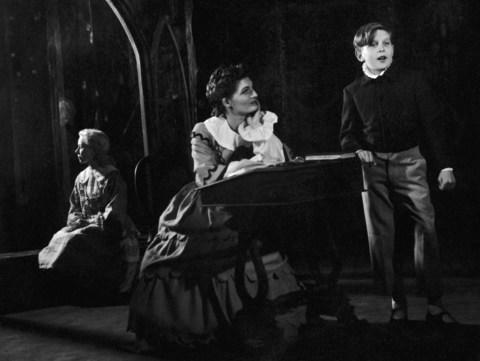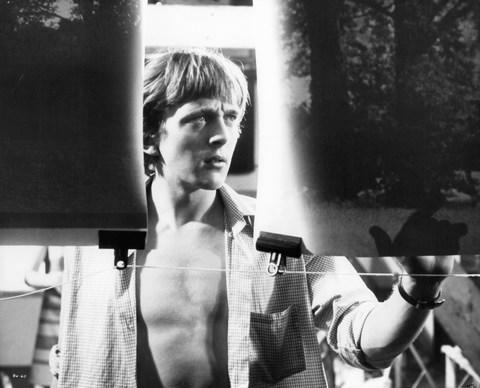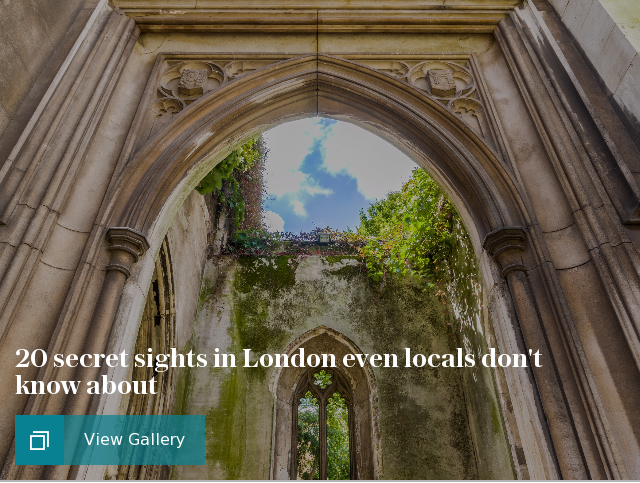Blow-Up and the forgotten red buildings on the Stockwell Road

Stockwell Road isn’t the most handsome of roads. It may have been once, but the Luftwaffe and typical unimaginative post-war redevelopment put paid to that. It’s got a skateboard park called ‘Brixton Beach’, if that’s your thing, and David Bowie was born in a road just off it (40 Stansfield Road in January 1947), but even he moved to Bromley when he was six. And that’s about it, to most people, even if they live there, it’s just a nondescript road that joins up Stockwell and Brixton.

But if you walk a short distance towards Stockwell from the skateboard park, and you stop and look carefully at the end of a terrace, you can see a tiny bit of red paint showing through some peeling cream emulsion. It’s the remnants of a lot of red paint and a clue that in the winter of 1966 this road made a glamorous appearance, alongside David Hemmings, the model Veruschka, and Vanessa Redgrave, in THE swinging Sixties London film – Michelangelo Antonioni’s Blow-Up. It was the Italian director’s first film in English and it was David Hemmings’ first major film role.
On stage, however, Hemmings had already been a star, of sorts. In 1954, 13 years before Blow-Up was released, a 12-year-old Hemmings had appeared, as a boy soprano, in Benjamin Britten’s opera The Turn of the Screw. He later spoke of the composer: “I loved him dearly, I really did – I absolutely adored him. I didn’t fancy him, I did go to bed with him, but I didn’t go to bed with him in that way.”

Hemmings’ opera career with Britten came to a particularly abrupt end. The English Opera Group had taken The Turn of the Screw to the Théâtre des Champs-Elysées in Paris. It was 1956 and Hemmings was now 15. In the middle of Miles’ main aria, ‘Malo’, Hemming’s voice suddenly broke. Britten was horrified and stopped the orchestra immediately. The curtain slowly lowered and Britten did not speak to, or even acknowledge, Hemmings ever again.
Ten years later Antonioni chose Hemmings for the role in Blow-Up because he wanted a fresh young actor who had no self-conscious acting style. The Italian director detested ‘Method’ acting, and in The Passenger, filmed in London in 1974, Antonioni kept saying to Jack Nicholson, “Jack, less twitching”.

The shoot for the film began in April 1966 and wherever the filmmakers went they left their mark on London. Antonioni thought the roads were a bit grey in Woolwich and had them painted black, and it was said that even pigeons were dyed so they were just the right sort of pigeons. The Rolls-Royce, once owned by Jimmy Savile, was originally white and the director had that re-sprayed to black. When the audience saw Hemmings drive his Rolls Royce down a long terrace of bright red Victorian and Edwardian buildings many presumed that Antonioni had had them all re-painted at great expense. But the buildings on Stockwell Road really were that colour in 1966 and were made up of dozens of properties all owned by the motorcycle spares company, Pride and Clarke, and every single one painted red.
The company was founded in 1920 by John Pride and Alfred Clarke and was based on the Stockwell Road for over 60 years. In its heyday the showrooms of ‘Snide and Shark’, as they were occasionally called, took up a huge stretch of the road and if the Guinness Book of Records had ever been interested in motorbike spares’ counters, they would have featured Pride and Clarke’s because it was the longest in the world. About 2,000 new motorbikes were on display plus a good selection of traded-in second hand machines in their showrooms. On a Saturday afternoon, around the time Blow-Up was being made, thousands of bikers from all over the country would congregate outside the bright-red Pride and Clarke shopfronts.

Michelangelo Antonioni, who in 1960 won the Special Jury Prize at Cannes with his film L’Avventura, wrote an article in that year’s December edition of Films and Filming entitled: Eroticism – The Disease of Our Age. He asked: “Why are literature and the entertainment arts so thick with eroticism today? It is the more obvious symptom of an emotional sickness.” Six years later, taking no notice of himself whatsoever, Blow-Up became known as the first British mainstream film to show pubic hair, not to mention naked teenage models (including the 19-year-old wife of John Barry, Jane Birkin). Hardly anyone noticed though, as all around the country the public were treated to a censored version of the film. This was not because the British Board of Film Censors or the local authorities were trying to protect the public’s morals, but because the brief moments of nudity, in those more sheltered days, were being trimmed out by projectionists to add to their private collections.

The film was released in March 1967, just as most people, especially in the capital, were getting rather bored with the idea of ‘swinging London’. The result of which was mostly bad reviews from the critics in Britain. In Europe and America, however, it was often a different story. Richard Schickel in Life magazine wrote: “This movie seems to me one of the finest, most intelligent, least hysterical expositions of the modern existential agony we have yet had on film”. Many of the contemporary reviews spoke of the nudity featured, but none about how Hemmings’ photographer treated the women he encountered - much of it uncomfortable to watch these days. But the film is an enjoyable museum piece that, at least, gives us a good glimpse of groovy sixties London from the eye of an outsider. Additionally, if you want to stop the film at the right moments, you can see, briefly, Michael Palin and a young Janet Street Porter dancing in stripy Carnaby Street trousers during the Yardbirds nightclub scene.
A few years after the release of Blow-Up the motorcycle business started to change and during the seventies Japanese motorcycle companies such as Suzuki, Honda and Kawasaki were overtaking the old British and European marques. Alfred Clarke was an astute businessman (the nickname ‘shark’ wasn’t gained for nothing) and the Pride and Clarke firm was sold to Inchcape for about £3m in 1979.

Before the company and the red paint were whitewashed from history, however, the striking red buildings of the Pride and Clarke showrooms had one more brush with fame. In 1977, the former Montrose vocalist Sammy Hagar was in London to record his second solo album at Abbey Road. Known to his fans as the ‘Red Rocker’, someone at Capitol Records had the bright idea that the Pride and Clarke shops on the Stockwell Road were perfect for the cover of the so called Red Album (pictured top). So as not to look too downmarket, he was told to stand next to an expensive American car, also coloured red. There is no record of what Sammy Hagar made of the Stockwell Road and there’s no record left of the ubiquitous Pride and Clarke shops either. Unless you look very, very closely.

More by the author
The West End at war: Graham Greene's search for supper on the night of The Wednesday
Mini-skirts, Soviet spies and the Chelsea Palace – the fascinating history of the King's Road
London's most morbid pop location? The 'cursed' Mayfair flat where two music icons died
The forgotten story of the 'Dilly Dossers' and London's most luxurious hippy squat
Murder, fascists and Barbara Windsor – five curious things that happened in London hotels



